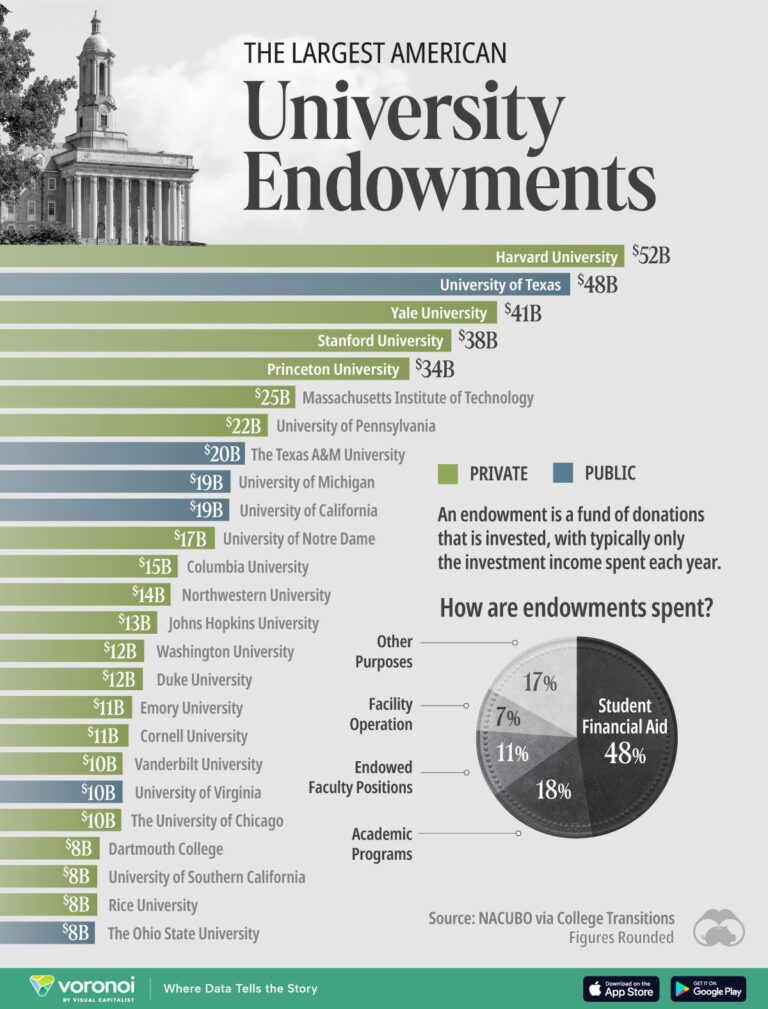In the competitive landscape of higher education, a college’s financial strength is often a key indicator of its ability to invest in cutting-edge research, attract top faculty, and provide robust student support. U.S. News & World Report’s latest compilation, “20 Colleges With the Biggest Endowments,” offers an incisive look at the institutions that hold the largest financial reserves. These endowments not only reflect years of strategic fundraising and alumni generosity but also play a critical role in shaping the academic and extracurricular opportunities available to students. This short list highlights the economic powerhouses of American academia, shedding light on how substantial endowments contribute to the enduring prestige and influence of these colleges.
Top Colleges Leading the Nation in Financial Endowments
Across the United States, several higher education institutions stand out for their impressive financial endowments, which fuel ground-breaking research, extensive scholarships, and expansive campus initiatives. These colleges have consistently demonstrated fiscal stewardship and strategic investment, allowing them to maintain competitive advantages in academic excellence and infrastructure development. Among the leaders, some universities have exceeded $30 billion in total assets, underscoring their dominance in the educational funding landscape.
Key factors contributing to these substantial endowments include:
- Robust alumni giving programs fostering long-term donor relationships
- Diversified investment portfolios crafted by expert financial teams
- Strong philanthropic commitments aligned with institutional priorities
- Innovative fundraising campaigns responding to global challenges
| College | Endowment Size (Billions) | State |
|---|---|---|
| Harvard University | $53.2 | MA |
| Yale University | $42.3 | CT |
| Stanford University | $37.8 | CA |
| Princeton University | $35.0 | NJ |
How Large Endowments Impact Educational Opportunities and Resources
Large endowments serve as the financial backbone for many top-tier universities, directly influencing the scope and quality of educational offerings. These substantial funds allow institutions to attract world-class faculty by offering competitive salaries and research grants, which in turn elevate academic rigor and innovation across all departments. Moreover, generous endowments enable expansive scholarship programs, reducing financial barriers for students and promoting socioeconomic diversity on campus.
Beyond academics, endowments have a transformative effect on campus infrastructure, student services, and global opportunities. Universities with significant financial resources can invest in state-of-the-art laboratories, cutting-edge technology, and extensive library collections—facilities that enrich the learning environment and fuel groundbreaking discoveries. Students also benefit from enhanced extracurricular programs, comprehensive career services, and robust study abroad initiatives that prepare graduates for a competitive global landscape.
- Increased access to merit and need-based financial aid
- Support for interdisciplinary research projects
- Improved mental health and wellness resources
- Expanded internship and networking opportunities
Strategies These Institutions Use to Sustain and Grow Their Financial Assets
Leading universities leverage a multi-faceted approach to ensure their endowments not only preserve value but also achieve robust growth amid fluctuating markets. Chief among these strategies is a disciplined investment philosophy, where portfolios are diversified across asset classes including equities, fixed income, real estate, and alternative investments such as private equity and hedge funds. This diversification helps institutions mitigate risks while capitalizing on higher-yield opportunities over the long term. Additionally, many schools employ specialized internal teams alongside external asset managers to optimize asset allocation and respond swiftly to market dynamics.
Philanthropic efforts also play a vital role, with universities cultivating strong relationships with alumni and major donors through targeted campaigns and exclusive giving opportunities. This not only replenishes financial reserves but also fosters a culture of sustained generosity. Furthermore, endowment spending policies are carefully calibrated to balance present needs with future growth, typically adhering to a spending rate around 4-5% annually to maintain intergenerational equity.
- Active risk management: Employing hedging strategies to safeguard principal.
- Impact investing: Aligning investments with social and environmental goals.
- Strategic partnerships: Collaborating with global financial institutions for new opportunities.
What Students Should Consider When Choosing Wealthy Endowed Colleges
When evaluating colleges with substantial endowments, students should prioritize how these funds translate into tangible benefits. Wealthy institutions often offer robust financial aid packages, lower average student debt, and extensive resources that enhance academic and extracurricular experiences. Prospective students should look beyond the size of the endowment and consider how effectively a college applies that wealth toward scholarships, research opportunities, and state-of-the-art facilities. Additionally, the stability of long-term funding can indicate a school’s ability to maintain or expand programs crucial to individual interests.
Key factors to weigh include:
- Scholarship and Aid Availability: Does the endowment support need-based or merit-based aid?
- Academic Investment: Are funds allocated to innovative research, faculty retention, and upgrades in technology?
- Campus Facilities: Quality and accessibility of libraries, labs, and residential life infrastructure.
- Career Support Services: Effective use of endowment money often includes bolstering internships, mentorships, and job placement.
| Endowment Size (in billions) | Average Financial Aid per Student | Graduation Rate |
|---|---|---|
| $40.9 | $57,000 | 95% |
| $31.2 | $45,000 | 93% |
| $25.7 | $52,000 | 96% |
The Conclusion
In summary, the landscape of higher education is significantly shaped by the financial strength of these institutions. The colleges featured in this short list not only boast substantial endowments but also leverage these resources to enhance academic programs, campus facilities, and student support services. As endowment figures continue to evolve, they remain a critical factor in the ongoing pursuit of educational excellence and innovation across the nation’s top universities. Staying informed about these financial standings offers valuable insight into the priorities and potential of America’s leading colleges.




